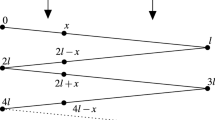Abstract
In this paper we study the exact controllability problem for the wave equation on a finite metric graph with the Kirchhoff–Neumann matching conditions. Among all vertices and edges we choose certain active vertices and edges, and give a constructive proof that the wave equation on the graph is exactly controllable if Neumann controllers are placed at the active vertices and Dirichlet controllers are placed at the active edges. The proofs for the shape and velocity controllability are purely dynamical, while the proof for the exact controllability utilizes both dynamical and moment method approaches. The control time for this construction is determined by the chosen orientation and path decomposition of the graph. We indicate the optimal time that guarantees the exact controllability for all systems of a described class on a given graph. While the choice of the active vertices and edges is not unique, we find the minimum number of controllers to guarantee the exact controllability as a graph invariant.











Similar content being viewed by others
References
Alam, M., Avdonin, S., Avdonina, N.: Control problems for the telegraph and wave equation networks. J. Phys. 1847, 012015 (2021)
Avdonin, S.: Control problems on quantum graphs. In: Analysis on Graphs and Its Applications. Proceedings of Symposia in Pure Mathematics, vol. 77, pp. 507–521. AMS (2008)
Avdonin, S.: Control, observation and identification problems for the wave equation on metric graphs. IFAC-PapersOnLine 52, 52–57 (2019)
Avdonin, S.A., Belinskiy, B.P., Ivanov, S.A.: On controllability of an elastic ring. Appl. Math. Optim. 60(1), 71–103 (2009)
Avdonin, S., Belinskiy, B., Pandolfi, L.: Controllability of a nonhomogeneous string and ring under time dependent tension. Math. Modell. Nat. Phenom. 5(4), 4–31 (2010)
Avdonin, S., Edward, J.: Exact controllability for string with attached masses. SIAM J. Control and Optim. 56(2), 945–980 (2018)
Avdonin, S., Edward, J., Zhao, Y.: Shape, velocity, and exact controllability for the wave equation on a graph with cycle (submitted)
Avdonin, S.A., Ivanov, S.A.: Families of Exponentials: The Method of Moments in Controllability Problems for Distributed Parameter Systems. Cambridge University Press, Cambridge (1995)
Avdonin, S., Kurasov, P.: Inverse problems for quantum trees. Inverse Probl. Imaging 2(1), 1–21 (2008)
Avdonin, S., Mikhaylov, V.: Controllability of partial differential equations on graphs. Appl. Math. 4(35), 379–393 (2008)
Avdonin, S., Nicaise, S.: Source identification problems for the wave equation on graphs. Inverse Prob. 31(9), 095007 (2015)
Avdonin, S., Zhao, Y.: Exact controllability of the 1-d wave equation on finite metric tree graphs. Appl. Math. Optim. 83(3), 2303–2326 (2021)
Belishev, M.I.: On the boundary controllability of a dynamical system described by the wave equation on a class of graphs (on trees). J. Math. Sci. (N.Y.) 132(1), 11–25 (2006)
Belishev, M.I., Vakulenko, A.F.: Inverse problems on graphs: recovering the tree of strings by the bc-method. J. Inverse Ill-posed Probl. 14(1), 29–46 (2006)
Berkolaiko, G., Kuchment, P.: Introduction to Quantum Graphs (Mathematical Surveys and Monographs), vol. 186. American Mathematical Society, Providence, RI (2013)
Dáger, R., Zuazua, E.: Wave Propagation, Observation and Control in 1-d Flexible Multi-structures, vol. 50. Springer, New York (2006)
Harary, F.: Graph Theory. Addison-Wesley, Reading (1969)
Kac, I., Pivovarchik, V.: On multiplicity of a quantum graph spectrum. J. Phys. A 44(10), 105301 (2011)
Knuth, D.E.: The Art of Computer Programming: Fundamental Algorithms. Addison-Wesley, Reading, MA (1997)
Lagnese, J.E., Leugering, G., Schmidt, E.J.P.G.: On the analysis and control of hyperbolic systems associated with vibrating networks. Proc. R. Soc. Edinburgh A 124(1), 77–104 (1994)
Lagnese, J.E., Leugering, G., Schmidt, E.J.P.G.: Modeling. Analysis and Control of Dynamic Elastic Multi-link Structures. Springer, New York (2012)
Lasiecka, I., Triggiani, R.: Control theory for partial differential equations: continuous and approximation theories. II. Abstract hyperbolic-like systems over a finite time horizon. In: Encyclopedia of Mathematics and its Applications, vol. 75. Cambridge University Press, Cambridge (2000)
Lions, J.-L.: Exact controllability, stabilization and perturbations for distributed systems. SIAM Rev. 30(1), 1–68 (1988)
Mehmeti, F.A.: Nonlinear waves in networks. Math. Res. 80, 171 (1994)
Mehmeti, F.A., Meister, E.: Regular solutions of transmission and interaction problems for wave equations. Math. Methods Appl. Sci. 11(5), 665–685 (1989)
Rolevicz, S.: On controllability of systems of strings. Studia Math. 36(2), 110–110 (1970)
Russell, D.L.: Controllability and stabilizability theory for linear partial differential equations: recent progress and open questions. SIAM Rev. 20(4), 639–739 (1978)
Szwarcfiter, J.L., Persiano, R.C.M., Oliveira, A.A.F.: Orientations with single source and sink. Discret. Appl. Math. 10(3), 313–321 (1985)
West, D.B.: Introduction to Graph Theory, vol. 2. Prentice Hall, Upper Saddle River (2001)
Zuazua, E: Controllability and observability of partial differential equations: some results and open problems. In: Handbook of Differential Equations: Evolutionary Equations, vol. 3, pp. 527–621. Elsevier (2007)
Zuazua, E.: Control and stabilization of waves on 1-d networks. In: Modelling and Optimisation of Flows on Networks. Lecture Notes in Math., vol. 2062, Springer, Heidelberg (2013)
Acknowledgements
The authors gratefully thank Julian Edward for very useful conversations about several parts of this manuscript and anonymous referee for valuable remarks. The research of Sergei Avdonin was supported in part by the National Science Foundation, Grant DMS 1909869. The research of Yuanyuan Zhao was supported by the National Science Foundation Graduate Research Fellowship under Grant No. 1242789.
Author information
Authors and Affiliations
Ethics declarations
Conflict of interest
The authors have not disclosed any competing interests.
Additional information
Publisher's Note
Springer Nature remains neutral with regard to jurisdictional claims in published maps and institutional affiliations.
Appendix
Appendix
We give equations in Sects. 3.4 and 3.7 for nonzero potentials. The solution to the forward problem for nonzero potentials are in parallel to the zero potentials case in Sect. 3.7, with Eq. (3.11) replaced by
(3.12) replaced by
The solution to the shape/velocity control problems for nonzero potentials are in parallel to the zero potentials case in Sect. 3.4, with Eq. (3.19) replaced by
(3.20) replaced by
(3.21) replaced by
(3.29) replaced by
(3.30) replaced by
Rights and permissions
About this article
Cite this article
Avdonin, S., Zhao, Y. Exact Controllability of the Wave Equation on Graphs. Appl Math Optim 85, 1 (2022). https://doi.org/10.1007/s00245-022-09869-w
Accepted:
Published:
DOI: https://doi.org/10.1007/s00245-022-09869-w




